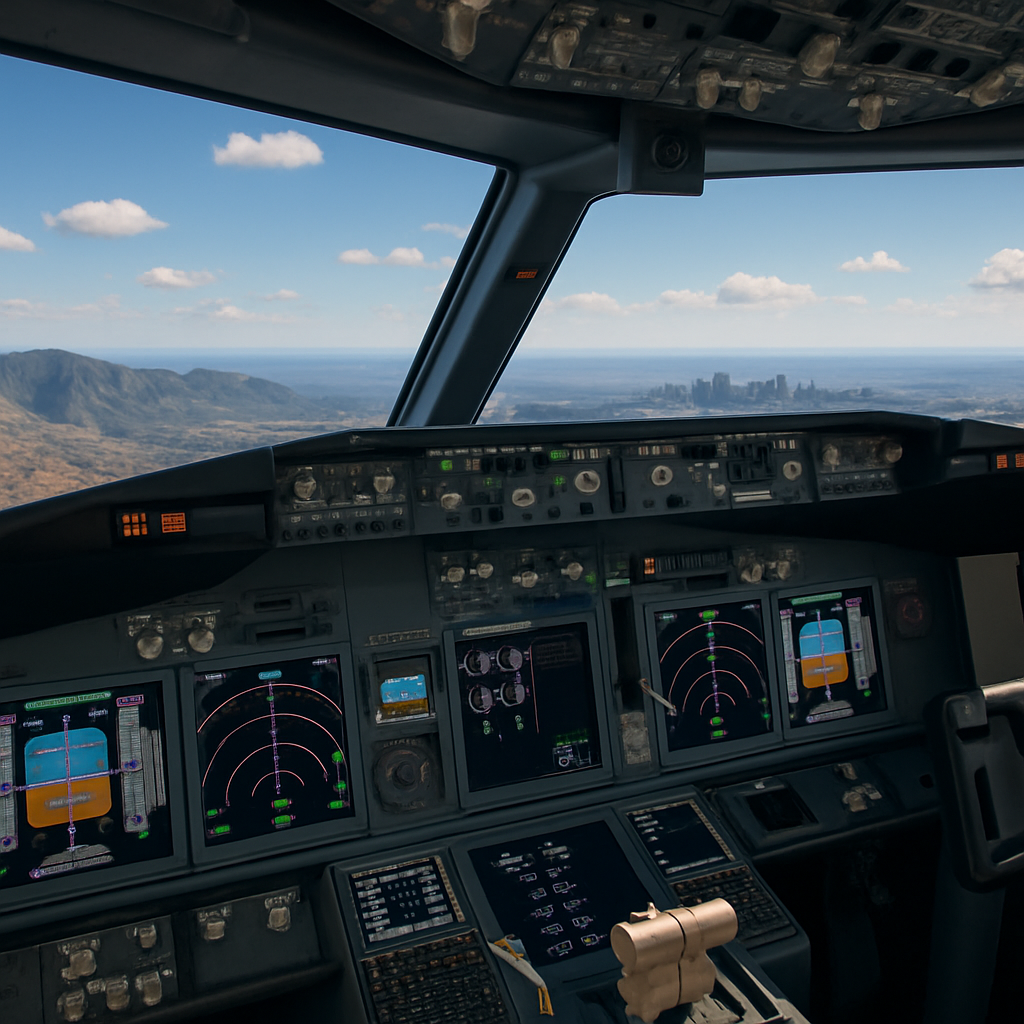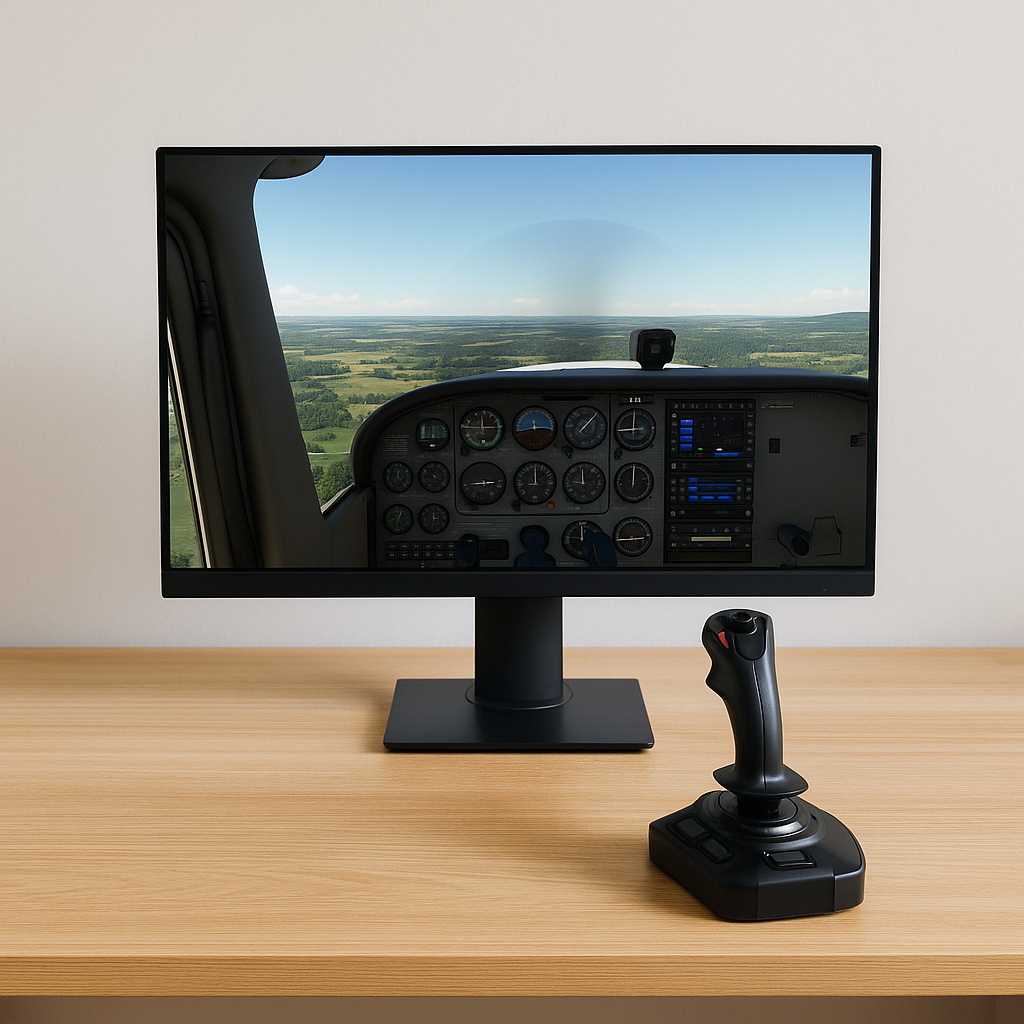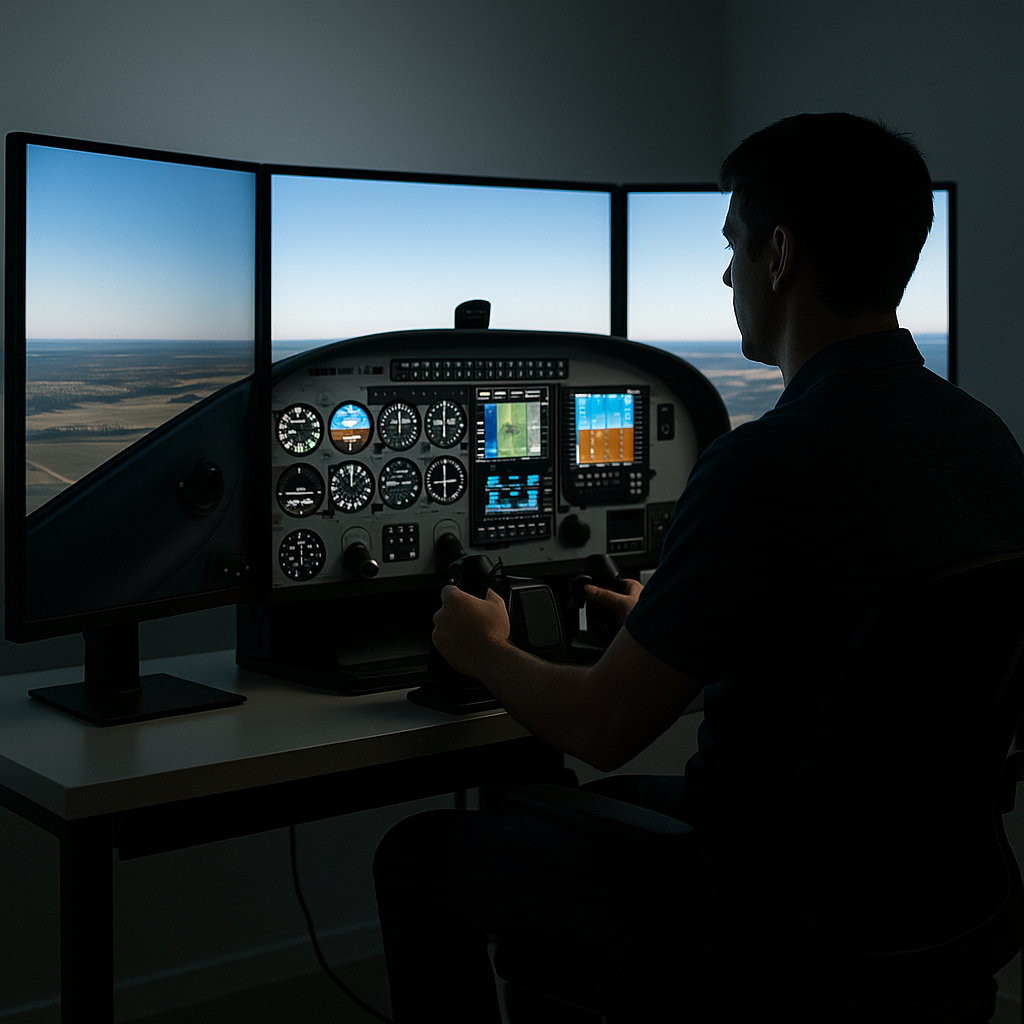Last updated on May 27th, 2025 at 10:11 pm

If you’ve ever wondered what it’s like to sit in the pilot’s seat and fly across the world without leaving your room, flight simulators make it possible. Over the years, I’ve tried just about every sim out there — from casual mobile apps to full-blown desktop setups. The options today can be overwhelming, especially if you’re just getting started. That’s why I’ve put together this breakdown — to help you find the right sim for your goals, your gear, and your flying style.
Understanding the Flight Simulator Landscape
Whether you’re a casual flyer who just wants to enjoy the scenery, or you’re someone chasing your next virtual instrument rating, there’s a sim for you. I’ve found that each program has its own strengths — some focus on stunning visuals, others go deep into flight mechanics or military realism. Knowing what matters most to you makes choosing a whole lot easier.
Flight simulators started off pretty simple, but now they span everything from browser-based training tools to large, realistic worlds that mimic real-time weather and air traffic. Many are built to support modding communities, so if you like tweaking and upgrading, there’s plenty to explore. Whether you’re chasing the feeling of a Cessna buzzing through local airspace or want to command a World War II fighter in the thick of battle, there’s a sim made for it. In recent years, the lines between entertainment, training, and simulation have grown even blurrier as developers build super detailed environments with near-photorealistic landscapes and authentic aircraft routines.
Top 10 Flight Simulator Programs Compared

I’ve rounded up ten of the most popular and respected flight simulators available right now. Each one brings its own strengths, quirks, and ideal uses to the table.
- Microsoft Flight Simulator (2020/2024 Update): Probably the most visually eye-catching sim out there, thanks to its use of Bing Maps and live weather data. You get everything from single engine trainers to heavy jets, paired with sky-high realism and a huge world to explore. This does mean it needs a powerful PC and has longer load times, but if you want immersion and next-level cool graphics, it’s hard to beat.
- X-Plane 12: Renowned for super realistic flight models and strong community mod support. X-Plane 12 handles flight physics really well, so if you care about how planes actually fly and want to practice procedures, it ticks a lot of boxes. The visuals aren’t quite as polished as MSFS, but the system depth and customization options are a big draw.
- Digital Combat Simulator (DCS World): The go-to for those who want to fly military aircraft with true-to-life avionics and weapon systems. DCS covers everything from dogfighting jets to helicopters, but there’s a learning curve. Not many civilian planes here, so it’s mostly about combat and tactics.
- Prepar3D (v5/v6): Designed with professional training in mind, Prepar3D is built on the bones of the old FSX, making it compatible with tons of legacy mods. Advanced customization for training is a big plus, but you’ll notice the graphics are a bit older, and the licensing can get pricey.
- Aerofly FS 4: A great choice for casual flyers and VR fans. The visuals are crisp, the performance is ultra smooth, and the controls are userfriendly. You get a decent aircraft selection, but you might find the weather and systems aren’t as detailed as elsewhere.
- Infinite Flight (Mobile): A full featured sim for your tablet or phone. It packs in global scenery, live ATC, and plenty of planes. You can’t interact with every switch, and you’ll need a subscription for full access, but for flying on the go, it’s surprisingly robust.
- FlightGear: An open source sim that’s great for messing around, learning, or coding your own features. It’s free and flexible, making it handy for educational setups, but the visuals and aircraft quality are all over the place.
- GeoFS (Web based): Run this right in your browser, no fancy hardware needed. The graphics are simple but let you hop in and fly anywhere in the world very quickly. Best for beginners or anyone who wants to run fast training sessions without a download.
- Rise of Flight: Get into World War I air battles with some of the most accurate visuals and dogfighting you’ll find for the era. It’s awesome for history fans, but being an older game, the graphics and game engine are starting to show their age.
- IL-2 Sturmovik: Great Battles: This sim is well known for bringing World War II air combat to life. You’ve got realistic damage models, VR support, and a stack of iconic planes. It’s all about the dogfights, though, so not much for fans of peaceful cruising.
Getting Started with Your First Flight Simulator

If you’re new to flight sims, your choice often comes down to what you enjoy most — visuals, realism, or just having fun — and what kind of setup you’re working with. I started out with a basic joystick and a mid-range PC, and that was more than enough to get immersed. These days, there are options for every level, whether you’re flying on a phone or a full desktop rig. If you prefer using a Mac or love fine tuning flight models, X-Plane 12 deserves a look. For absolute beginners or folks on a tight budget, giving FlightGear or GeoFS a try is a pretty low-risk way to get your wings. You can also check out my list of beginner-friendly flight simulators for a closer look at some great starting options.
Each sim uses a different approach for controls, weather, and scenarios. Most let you use gamepads, joysticks, or even full yoke and rudder pedal setups for that proper cockpit feel. Think about the hardware you have, and whether you plan to invest in a flight stick or just use your keyboard for now.
- Hardware Requirements: Programs like MSFS and X-Plane 12 need plenty of processing power and dedicated graphics. Web based or mobile sims will run on just about anything.
- Learning Curve: Some, like DCS World, toss you into complex procedures, while others like Aerofly FS 4 keep the setup smooth and easy to handle right from the start.
- Community Mods and Addons : If you want to customize your experience, check out X-Plane 12 and Prepar3D, which truly shine here. Add-ons can give a serious boost to your experience by adding new planes, custom airports, or improved scenery. If you’re just getting started, I recommend checking out some software and tools for novice pilots that can enhance your sim without overwhelming you.
While jumpstarting your flying adventure, keep in mind how often you want to upgrade your setup. Many sim fans begin with basic gear like a joystick and gradually move into full setups with rudder pedals, throttle quadrants, and VR headsets as their passion grows. You might also find it helpful to compare yokes vs. joysticks before investing in more advanced hardware.
What to Consider Before Choosing a Simulator
I’ve made a few decisions over the years with flight sims that I wish I’d thought through a bit more. Here are the things I’d suggest you pay attention to before hitting the download button:
- Cost and Licensing: Some flight simulators require up front payments or subscriptions. DCS is “free” at first, but you’ll want to pick up extra modules for the best aircraft and scenarios.
- Aircraft Selection: Not all sims offer the same planes. If you’re interested in flying military jets, civilian airliners, or niche historical planes, check the sim’s lineup first. Many expand with paid DLC, and a wider lineup often means more opportunities for skill building and fun discoveries.
- Visuals vs. System Depth: Decide if you want photorealistic landscapes (MSFS really shines here) or if you value realistic flight models and system simulation above all (in which case, XPlane’s your game).
- Mod Support and Community: Usercreated content adds great value, providing extra airports, aircraft, and scenarios. A strong community can also make things easier for troubleshooting and learning.
System Performance
Top tier simulators like MSFS and X-Plane 12 are pretty demanding. If you want to run them smoothly in VR or at higher resolutions, you’ll need a capable system. Check out my guide on how to optimize your PC for flight simulators for tips on getting the best performance.
Online Multiplayer and ATC
If flying with others or talking to virtual air traffic controllers sounds fun, look for sims that support multiplayer. Infinite Flight and MSFS both offer live ATC and bustling online skies, while DCS and IL-2 keep their focus on combat missions and team play. Multiplayer also opens up new opportunities for collaborative flying and real time scenery sharing with fellow enthusiasts.
Learning Resources
Flight sims can get overwhelming fast — I’ve been there. If some of the terminology is tripping you up, be sure to refer to this helpful flight simulator terms glossary — it clears up a lot when you’re navigating your first sim environment. Fortunately, there’s a huge community out there full of great tutorials, YouTube guides, and helpful forums. I’ve learned a ton just by asking questions and testing things out one flight at a time.
Cool Features That Stand Out in Modern Flight Sims
- Dynamic Weather: MSFS can fetch live weather updates, letting you fly through storms or shoot an approach in thick fog, just as in real life. Many simulators are starting to expand this feature with even more realistic cloud modeling and turbulence simulation.
- Virtual Reality (VR): More sims are adding VR support for ultra immersive cockpits. Aerofly FS 4, X-Plane 12, MSFS, and IL2 all pull off this next-level cool experience that puts you right in the pilot’s seat.
- RealWorld Navigation: Some simulators let you use real navigational aids and are regularly refreshed with new charts and procedures. Staying current helps you feel more like a real world pilot.
- Addon Support: Want to fly your local airstrip or a rare aircraft? Sims with active modding communities greatly expand your options and help keep the experience fresh as new content spreads like wildfire.
Flight Simulators in Practical Use

Many real world pilots now train with home flight sims to keep their skills sharp between sessions in a real cockpit. Flight schools even use programs like X-Plane 12 and Prepar3D to run through procedures before students strap in. At the same time, history fans and military aviation enthusiasts keep the past alive flying missions in IL2 or Rise of Flight. For aviation lovers, these simulations are a fun way to stumble upon new airports or remote landscapes you might never track down in person.
- Pilot Training: Practicing checklists, approaches, and emergencies in a risk-free setting.
- Air Traffic Control Simulation: Some platforms like Infinite Flight and MSFS include online ATC where users can play both pilot and controller roles, deepening the realism and helping new aviators get a sense of real world radio work.
- Aviation Exploration: Casual flyers tour the world’s famous landmarks without ever booking a ticket. Explorers can compare different regions and see what makes each location unique from above, adding some variety to their virtual rides.
Frequently Asked Questions
Which flight simulator has the best graphics?
Microsoft Flight Simulator (2020/2024) takes the lead for visuals with its real world photogrammetry and live weather details, making every flight feel more real.
Is there a good free flight simulator for beginners?
FlightGear and GeoFS are both free and great for newcomers. FlightGear is particularly flexible for tinkering, while GeoFS works right in your browser for a low commitment introduction.
Can I use a regular controller or do I need special flight gear?
Most sims support gamepads, and several work fine with keyboard and mouse. For more realism, flight sticks, yokes, and pedals do give a boost, but aren’t required to start out. Many modern sims make it easy to use whatever you already have.
Are there flight sims for mobile devices?
Yes! Infinite Flight and X-Plane Mobile both cater to touchscreens and let you fly a variety of aircraft anywhere, anytime.
Choosing the Right Flight Simulator for You
At the end of the day, the best flight sim for you really depends on what you enjoy most and how you like to fly. Whether you’re chasing beautiful scenery, mastering complex aircraft systems, or diving into historical combat missions, there’s a sim out there that fits your style. I’ve tried them all over the years, and the fun really begins when you find the one that clicks with you. Hopefully, this guide gives you a solid head start — now it’s your turn to take off and explore the skies, your way.
Each program has its own strengths — some focus on stunning visuals, others go deep into flight mechanics or military realism. Knowing what matters most to you makes choosing a whole lot easier. You can explore this further in my guide on choosing the right flight simulator.
